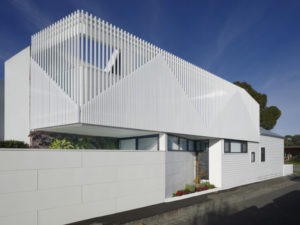Project Description
‘The Little House’ on the parking lot is the story of a house that uses less energy than it produces, is built of old shipping containers and can be transported by land or sea. However, it is not just a house. It is a factory- built product, with endless opportunities for individual customisation, with regard to climate, culture and style. You configure your house online and sixteen weeks later you move in. The prototype is built in Denmark and the first houses will be built in Wuxi, China. They are a low-carbon, resource-efficient solution for the fast growing country. The project has been developed for worldFLEXhome in collaboration with a wide range of producers, the Danish Technological Institute and technical advisors. In many ways the project reflects Arcgency’s work: architecture that is defined by resource efficiency, individual solutions for people and alterative building methods.
The WFH Concept
The WFH concept is a patented modular building system, based on a design principle using 40-feet-high standard modules as a structural system. The structure can be adapted to local challenges such as the climate or earthquakes. It is the first prefabricated housing system that meets the demands of the international environmental building standard. The structure can be configured for a range of purposes and in different forms, such as multi-storey, townhouses, cluster houses or individual villas. Its advantages are an optimum indoor climate, low energy consumption, environmentally sound materials, a short construction period and that can be dismantled for recycling or relocation. Online customisation tools enable clients to decide their own version of the house as regards layout, size, façade, interior etc. It is configured within a predefined framework that ensures high architectural standards and quality of materials. It is cost-efficient compared to other green houses. The building components are prefabricated and on-site assembly is limited. The design allows for high-quality industrial production in large numbers and distribution using standard container transport.
WFH House facts
The WFH House measures 180 square metres. Energy consumption is 50% lower than the standard requirements for new housing construction in Denmark. Photovoltaic cells are integrated. The house features green roof solutions that are optimised for rainwater harvesting for use for toilet flushing, washing and cleaning. It also has customised façade solutions.
Design
The design is based on Nordic values, not only with regard to architecture, but also to design elements. These values are defined as: flexibility, building for people and human values, good daylight conditions, different types of light, reliable (long term) solutions, healthy materials, recyclable materials, design for easy dismantling, materials that age gracefully, access to nature and greenery, a minimalistic look, playfulness.
FLEX space
The FLEX space is the heart of the house. It contains the living room and kitchen and can be used for multiple purposes. Parts of the room are double height, creating perfect lighting conditions. The rest of the space is one storey height, delineated by the landing that provides access to the spaces on the second floor. At each end of the FLEX space there is access to the surrounding outdoor area and daylight. The boundary between inside and outside disappears when the doors open. This is a fundamental aspect of the design: to be able to open it up and let nature in. The geometry of the FLEX space is defined by two rows of modules and can easily be adapted to specific size requirements. The FLEX space can be subdivided variously and can also be one big, light and open space. The kitchen units are built into the wall (into the technical module), which creates more floor space and also facilitates connection to water and plumbing. The kitchen can also be extended with a freestanding element, defining the work area of the kitchen. The FLEX space provides access to all spaces. This eliminates surface area used for logistics. It is possible to include larger openings from the FLEX space into the rooms, again creating flexible solutions within the same system.
Bedrooms
The size of the bedrooms is defined by half of a module (15m²). There are four bedrooms and they can be used for multiple purposes: parent’s bedroom, kids’ bedroom, workspace etc. Three of the rooms have windows on two façades, creating a mixture of light. It is possible to remove the wall, or part of it, facing the FLEX space. This adds flexibility to the layout and shows the ability of the structural system to adapt to different needs.
Landing
The landing provides access to the second floor, but can also be used as a space for playing, relaxation or work. It gives the resident the possibility to withdraw, but still enjoy the company of people in the house. You are in the FLEX space, but because you are on the first floor you can be away from the action. It is an ideal place to retreat quietly while still being able to observe what is going on in the house.






























